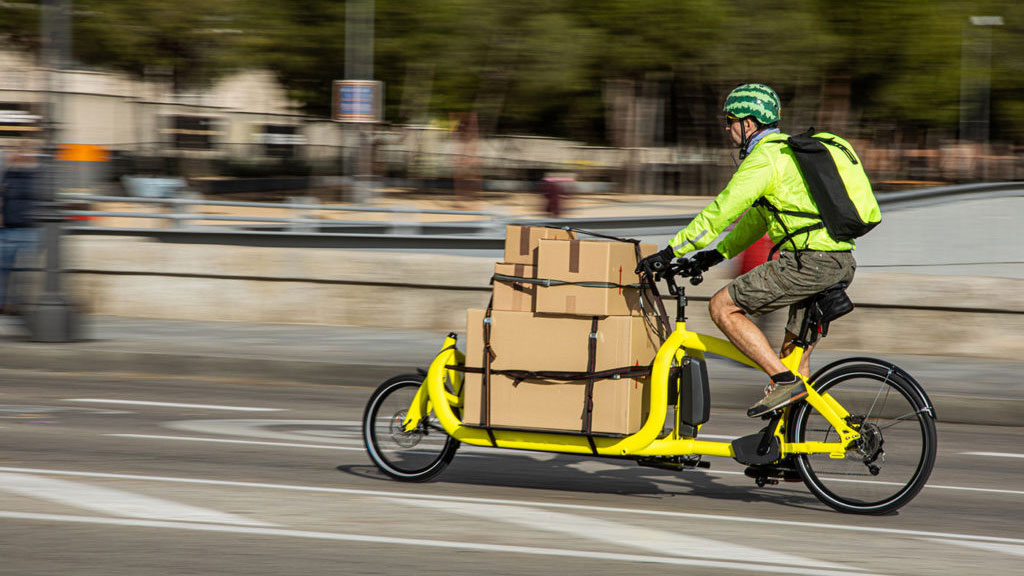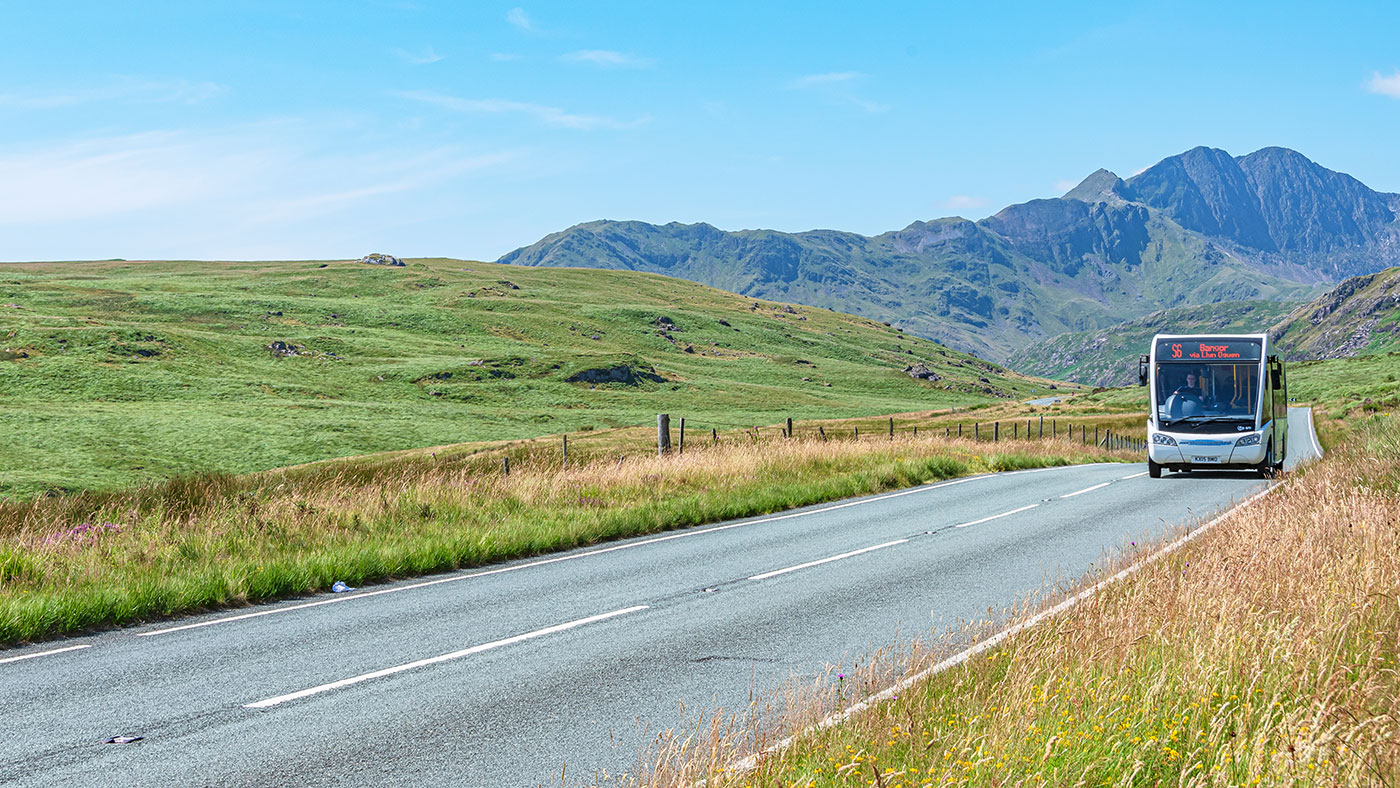A concern often raised about plans to reduce traffic in towns and cities is the question “what about goods deliveries”?
Freight transport is obviously vital for delivering goods to shops, homes and businesses. Yet our over-reliance on heavy goods vehicles (HGVs) for freight transport is seriously harmful:
- Safety: HGVs account for only 3.6% of motor-vehicle mileage on Britain’s road network (excluding motorways), yet they are involved in 14% of pedestrian fatalities and 17.5% of cyclist fatalities. People hit by lorries are much more likely to be killed than those hit by (other) cars.
- Road maintenance: the damage caused by a vehicle increases exponentially with its weight, meaning that a 44-tonne lorry does 136,000 times more damage to a road than a typical small car. Lorries are also much more likely to over-run kerbs and pavements, and to damage verges on rural roads and lanes.
- Emissions: lorries are responsible for 17% of greenhouse gas emissions from road transport and 21% of nitrogen dioxide emissions, even though they account for just 5% of road traffic mileage (including motorways).
In recent years, a decline in the GB population’s annual average car mileage has been offset by an increase in van mileage, with the result that road traffic overall continues to grow. This is to a large extent driven by the growth in home deliveries, which in turn has increased during the pandemic.
So how can we reduce these problems while still delivering the goods?.
Inter-urban freight
Part of the answer is to get more of our goods delivered by rail. Rail is obviously well suited to carrying heavy or bulky goods and could take a lot of lorries off our motorways: 50% of trips made by articulated lorries are over 200kms in length, with 25% being over 300km. More well-placed rail-freight terminals are needed to increase the opportunities for rail freight.
Improved collaboration and data-sharing within the logistics industry could also help to reduce the c29% of GB HGV mileage where the lorry runs empty.
The use of self-driving lorries on motorways may soon contribute to reductions in the costs and the environmental and safety impacts of road freight for journeys that cannot be made by rail.
Trans-shipment depots and urban logistics, including cargo bikes
However this in turn will depend on the more widespread use of trans-shipment depots, where large lorries can transfer their loads onto smaller urban delivery vehicles, including cargo bikes, for delivery to shops and other destinations within urban areas. This would reduce the safety risks of large lorries in urban areas, not to mention the road maintenance damage and indeed their requirements for wide-cornered junctions, which impede efforts to slow motor vehicles and enable pedestrians to cross at junctions.
The EU-funded Cycle Logistics project found that 51% of urban freight journeys could be undertaken by cargo bike. More recent research by the Active Travel Academy, commissioned by the charity Possible, found that cargo bikes made urban deliveries around 60% faster than vans (delivering 10 parcels per hour, compared with 6 per hour for vans), as well as reducing congestion, road danger, air pollution and greenhouse gas emissions
A concern often raised about plans to reduce traffic in towns and cities is the question “what about goods deliveries”?
Freight transport is obviously vital for delivering goods to shops, homes and businesses. Yet our over-reliance on heavy goods vehicles (HGVs) for freight transport is seriously harmful:
- Safety: HGVs account for only 3.4% of motor-vehicle mileage on Britain’s road network (excluding motorways), yet they are involved in 13% of pedestrian fatalities and 18% of cyclist fatalities. People hit by lorries are much more likely to be killed than those hit by (other) cars.
- Road maintenance: the damage caused by a vehicle increases exponentially with its weight, meaning that a 44-tonne lorry does 136,000 times more damage to a road than a typical small car. Lorries are also much more likely to over-run kerbs and pavements, and to damage verges on rural roads and lanes.
- Emissions: lorries are responsible for 19% of greenhouse gas emissions from road transport and 16% of PM2.5 particulate emissions, even though they account for just 5% of road traffic mileage (including motorways).
In recent years, a decline in the GB population’s annual average car mileage per person has been offset by population growth and an increase in van mileage, with the result that road traffic overall continues to grow. The growth in home deliveries, particularly since the pandemic, is clearly a significant factor.
So how can we reduce these problems while still delivering the goods?

"Freight transport is obviously vital for delivering goods to shops, homes and businesses. Yet our over-reliance on heavy goods vehicles for freight transport is seriously harmful."

"Freight transport is obviously vital for delivering goods to shops, homes and businesses. Yet our over-reliance on heavy goods vehicles for freight transport is seriously harmful."
A concern often raised about plans to reduce traffic in towns and cities is the question “what about goods deliveries”?
Freight transport is obviously vital for delivering goods to shops, homes and businesses. Yet our over-reliance on heavy goods vehicles (HGVs) for freight transport is seriously harmful:
- Safety: HGVs account for only 3.6% of motor-vehicle mileage on Britain’s road network (excluding motorways), yet they are involved in 14% of pedestrian fatalities and 17.5% of cyclist fatalities. People hit by lorries are much more likely to be killed than those hit by (other) cars.
- Road maintenance: the damage caused by a vehicle increases exponentially with its weight, meaning that a 44-tonne lorry does 136,000 times more damage to a road than a typical small car. Lorries are also much more likely to over-run kerbs and pavements, and to damage verges on rural roads and lanes.
- Emissions: lorries are responsible for 17% of greenhouse gas emissions from road transport and 21% of nitrogen dioxide emissions, even though they account for just 5% of road traffic mileage (including motorways).
In recent years, a decline in the GB population’s annual average car mileage has been offset by an increase in van mileage, with the result that road traffic overall continues to grow. This is to a large extent driven by the growth in home deliveries, which in turn has increased during the pandemic.
So how can we reduce these problems while still delivering the goods?.
Inter-urban freight
Part of the answer is to get more of our goods delivered by rail. Rail is obviously well suited to carrying heavy or bulky goods and could take a lot of lorries off our motorways: 50% of trips made by articulated lorries are over 200kms in length, with 25% being over 300km. More well-placed rail-freight terminals are needed to increase the opportunities for rail freight.
Improved collaboration and data-sharing within the logistics industry could also help to reduce the c29% of GB HGV mileage where the lorry runs empty.
The use of self-driving lorries on motorways may soon contribute to reductions in the costs and the environmental and safety impacts of road freight for journeys that cannot be made by rail.
Trans-shipment depots and urban logistics, including cargo bikes
However this in turn will depend on the more widespread use of trans-shipment depots, where large lorries can transfer their loads onto smaller urban delivery vehicles, including cargo bikes, for delivery to shops and other destinations within urban areas. This would reduce the safety risks of large lorries in urban areas, not to mention the road maintenance damage and indeed their requirements for wide-cornered junctions, which impede efforts to slow motor vehicles and enable pedestrians to cross at junctions.
The EU-funded Cycle Logistics project found that 51% of urban freight journeys could be undertaken by cargo bike. More recent research by the Active Travel Academy, commissioned by the charity Possible, found that cargo bikes made urban deliveries around 60% faster than vans (delivering 10 parcels per hour, compared with 6 per hour for vans), as well as reducing congestion, road danger, air pollution and greenhouse gas emissions
A concern often raised about plans to reduce traffic in towns and cities is the question “what about goods deliveries”?
Freight transport is obviously vital for delivering goods to shops, homes and businesses. Yet our over-reliance on heavy goods vehicles (HGVs) for freight transport is seriously harmful:
- Safety: HGVs account for only 3.4% of motor-vehicle mileage on Britain’s road network (excluding motorways), yet they are involved in 13% of pedestrian fatalities and 18% of cyclist fatalities. People hit by lorries are much more likely to be killed than those hit by (other) cars.
- Road maintenance: the damage caused by a vehicle increases exponentially with its weight, meaning that a 44-tonne lorry does 136,000 times more damage to a road than a typical small car. Lorries are also much more likely to over-run kerbs and pavements, and to damage verges on rural roads and lanes.
- Emissions: lorries are responsible for 19% of greenhouse gas emissions from road transport and 16% of PM2.5 particulate emissions, even though they account for just 5% of road traffic mileage (including motorways).
In recent years, a decline in the GB population’s annual average car mileage per person has been offset by population growth and an increase in van mileage, with the result that road traffic overall continues to grow. The growth in home deliveries, particularly since the pandemic, is clearly a significant factor.
So how can we reduce these problems while still delivering the goods?





